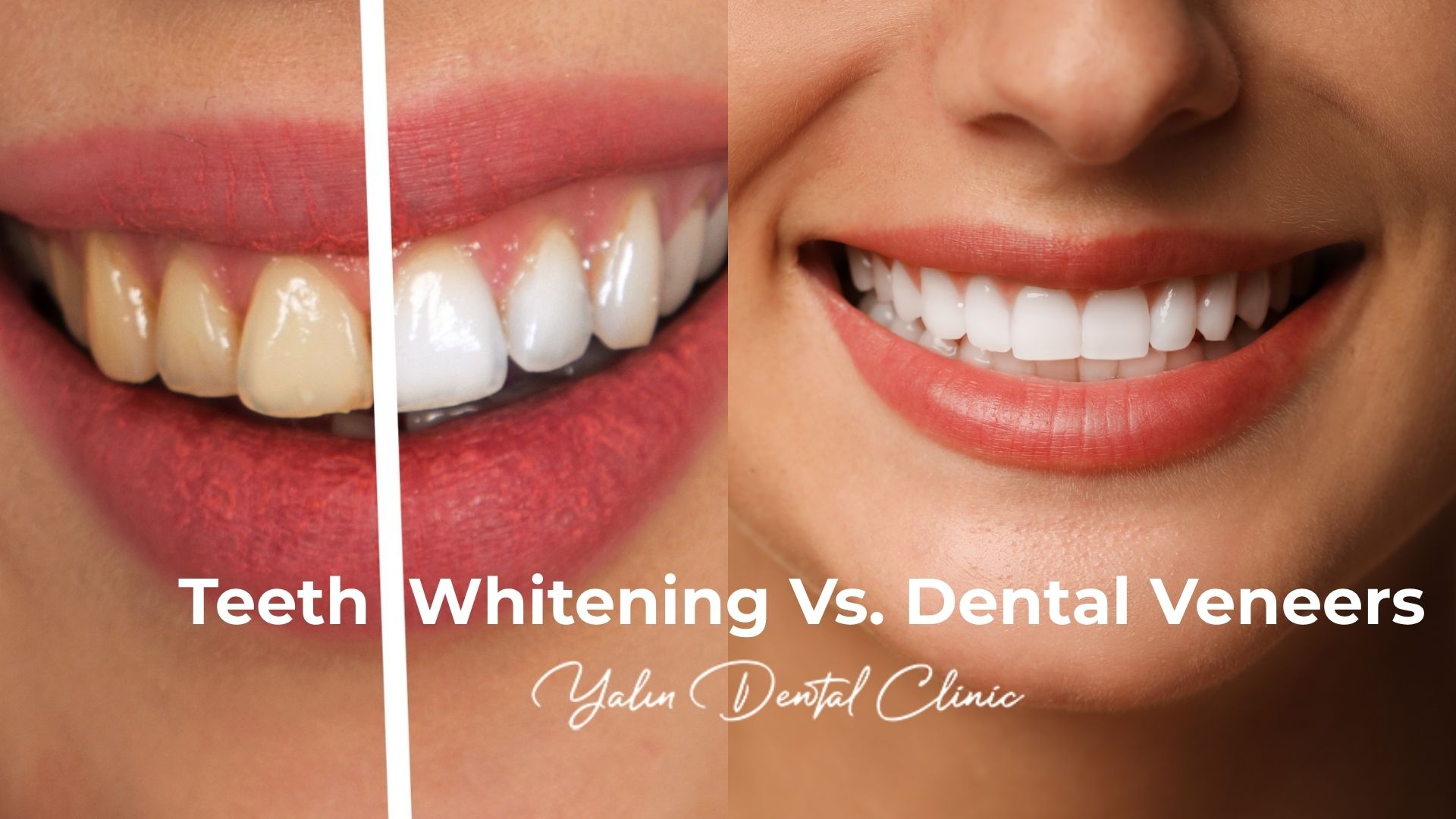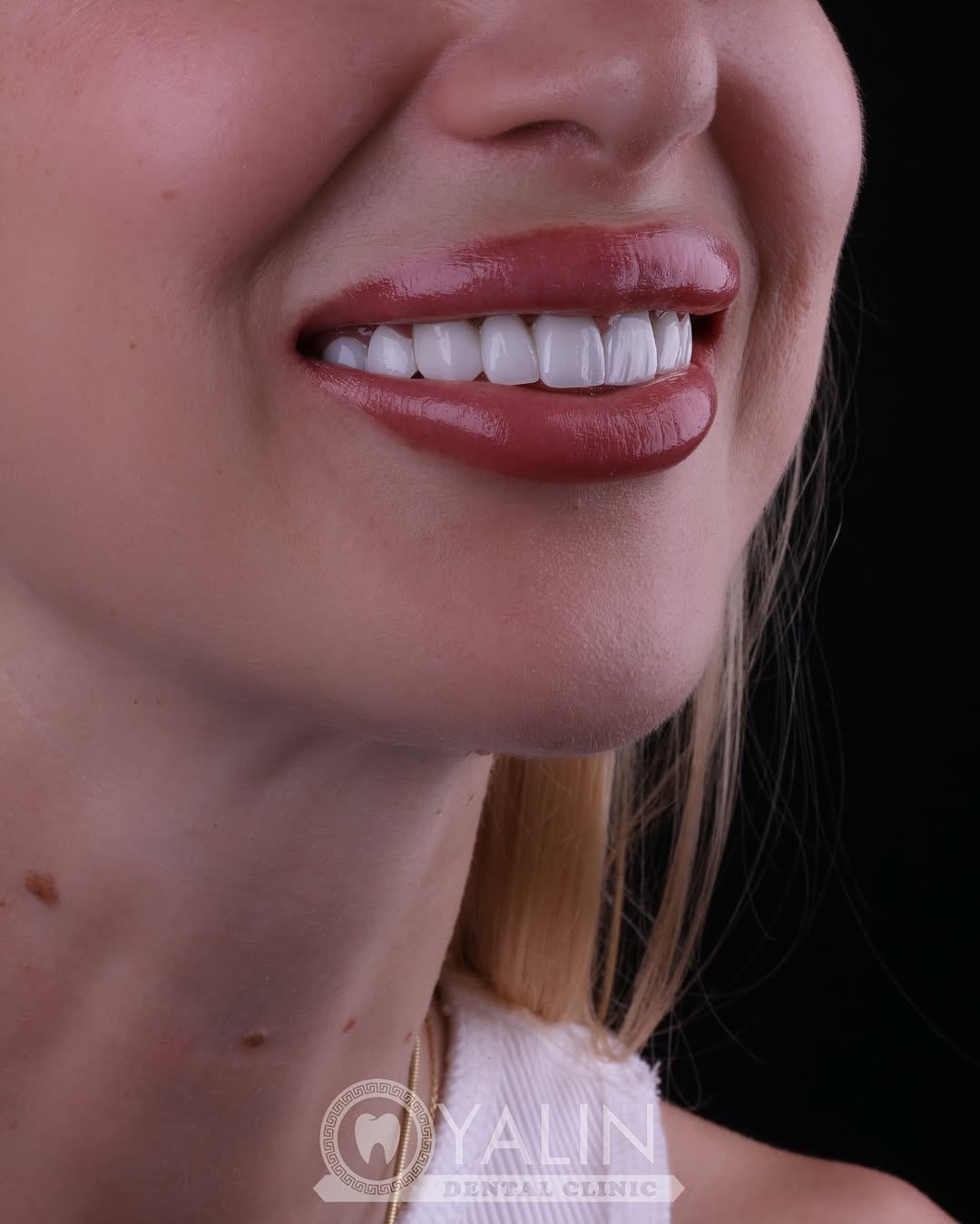Want a brighter smile? You’re not alone. In 2024, people spent over billions on teeth whitening and veneers. That’s a lot of sparkle
But here’s the thing: teeth whitening and veneers. aren’t the same. One lifts stains, the other reshapes your smile. Both can make a big difference, depending on what you’re after.
Let’s break them down, step by step.

What is teeth whitening?
It is a simple way to lighten the natural colour of your teeth using gentle bleaching agents like hydrogen peroxide or carbamide peroxide. You can do it at the dentist, with custom trays at home, or with store strips. Works on natural teeth, not on crowns or veneers. Mild sensitivity can happen and usually fades in a few days.
What are veneers?
Thin, custom shells that sit on the front of your teeth to fix chips, heavy stains, small gaps, or uneven shapes. Think of them like a made-to-measure face for each tooth. Two main options: porcelain veneers (most natural look and keeps colour longer) and composite (faster, easier to repair). Your dentist usually trims a little enamel, so it’s not a reversible step. With good care and regular checkups, they can last many years.
Veneers and teeth whitening procedure
If you’re doing both, start with teeth whitening;
- Quick check and shade photo
- Whitening session
- At-home top-up (if needed)
- Settle time
We look at your current colour and pick a goal shade so we know when to stop.
At the clinic, gel goes on the teeth, the lips and gums are protected, and we run 2 to 3 short rounds. You just lie back. You may feel some zingy sensitivity. That’s normal.
You might receive custom trays and gel for a week. Wear them 30 to 60 minutes a day unless we say otherwise.
Wait about 7 days after your last whitening so the colour stabilises. Then we lock in the new shade for your veneers.
Now, veneers step by step

- Smile plan
- Minimal prep day
- Lab time
- Try-in
- Bonding
- Bite check and instructions
We talk about what you want fixed and choose shape and color. Quick photos and a scan. If you like, we do a quick mockup so you can “see” the idea on your teeth.
We numb the tooth so you’re comfortable. A very thin layer of enamel is smoothed so the veneer sits flush, not bulky. Another scan goes to the lab. You leave with temporary veneers that already look close to the plan.
Your custom porcelain is made to match your new whitened color. This usually takes 5 to 10 days. Eat normally but be gentle with hard or sticky foods while you wear temporaries.
We place each veneer without glue first. You check the mirror. We check the fit, edges, and bite. Want the tooth a touch shorter or slightly brighter? Say it now. Tiny tweaks are easy here.
Once you love the look, we clean the tooth, treat the surface, and bond the veneer. A special light sets the cement in seconds. We polish the edges so everything feels like your own tooth.
We have you bite, smile, talk, and drink water. If anything feels high or sharp we adjust on the spot. You get simple care tips and we schedule a quick follow up.
Care that keeps them perfect
Soft toothbrush, non-abrasive toothpaste, daily flossing, and regular cleanings. Avoid opening packages with your teeth, and wear a night guard if you clench. Coffee, tea, and wine are fine; just rinse after and keep up hygiene so the edges stay stain-free.
What problems can veneers and teeth whitening solve?
Teeth whitening is about colour. If your teeth are basically healthy but look yellow from coffee, tea, red wine, smoking, or just time, peroxide gels lift those stains so everything looks cleaner and brighter. It is great when you like the shape of your teeth and just want them lighter, or when you are getting ready for an event and want a quick refresh.
Veneers help when the problem isn't just colour. Little chips, worn edges, small gaps, a tooth that looks shorter than the rest, or stains that don’t lighten with bleaching can all be covered with thin custom shells. They’re also great if a tooth is slightly misshapen or smaller than its neighbours. Think of whitening as polishing what you already have and veneers as reshaping the look. If there’s decay or gum trouble, we fix that first, and bigger alignment issues usually need orthodontics before either treatment.
Comparing Veneers and Teeth Whitening
Both can upgrade your smile, but they do it in different ways. Whitening lifts colour from your natural enamel. Veneers change the look of the tooth when colour alone isn’t the main issue.
|
VENEERS |
TEETH WHITENING |
|
Aim: Change shape, size, and color |
Aim: Brighten natural tooth color |
|
Best for chips, worn edges, small gaps, deep stains |
Best for general yellowing or surface stains |
|
Not ideal when decay or gum issues are present or |
Not ideal when Stains are inside the tooth or |
|
Time to result: |
Time to result: |
|
Durability: Many years with good care |
Durability: Needs touch-ups over time |
|
Reversible: No, a bit of enamel is trimmed |
Reversible: Yes, enamel stays intact |
|
Tooth changes: |
Tooth changes: |
|
Cost: Higher per tooth |
Cost: Lower overall, especially at home options |
Teeth whitening vs veneers pros and cons
Teeth whitening
Pros
- Fast boost in color
- No drilling, keeps your tooth shape
- Lower cost and easy to repeat
Cons
- Only changes color, not shape or gaps
- Sensitivity can pop up for a day or two
- Results fade, touch-ups needed
Veneers
Pros
- Fixes more than color. Chips, small gaps, worn edges, shape issues
- Big, instant makeover with precise shade and shape
- Resistant to stains compared to natural enamel
Cons
- Irreversible. A thin layer of enamel is trimmed
- Higher cost per tooth
- You still need good care and a night guard if you grind
Which option is right for you?
Think about what bugs you most. If you like your tooth shape and just want them brighter, go with whitening. It’s quick, budget-friendly, and easy to top up before a trip or event.
If you want more than colour-fixed chips, small gaps, worn edges, or deep stains that don’t lift, then veneers make sense. They’re a bigger change and cost more, but you control shape and shade.
Health first: any cavities or gum issues get sorted before either. If teeth are quite crooked, straighten them first, then finish with whitening or veneers.
Simple guide: bright only → whitening. Shape and colour makeover → veneers.
Comparing Cost of Veneer and Teeth Whitening
Think of whitening as a quick colour refresh and veneers as a full outfit change for your teeth. Whitening is usually one simple visit or a short at-home routine. No lab work, minimal materials, little chair time. That’s why it stays lighter on the wallet.
Veneers take more. There’s a smile plan, tiny enamel shaping, detailed scans, and a dental lab crafting custom shells for each tooth. Then a try-in, fine tweaks, and precise bonding so the bite and look are perfect. You’re paying for the lab’s craftsmanship, the dentist’s time and skill, and a result that changes both shape and colour in one go.
So, if you want a fast brightening, whitening does the job. If you want a bigger makeover with control over size, shape, and shade, veneers cost more because there’s more work, more steps, and more customisation behind that final smile.
How long do veneers and teeth whitening last?
With normal brushing, checkups, and a night guard if you grind, they often look great for 10 to 15 years. A systematic review reported that enamel-bonded porcelain veneers have a 99% survival rate over 10 years. Composite doesn’t last as long; think closer to 5 to 7. If you bite nails or crunch ice or hard objects, you’ll shorten that, so a few small habits really matter.
Are veneers better than teeth whitening?
It depends on what you want to fix. If you like your tooth shape and just want them brighter, whitening is the simple, lower-cost pick, and you can refresh it whenever the colour changes.
If you also want to fix chips, small gaps, worn edges, or deep stains that do not lift with bleach, veneers make more sense. They change shape and colour together, and the result is more dramatic, but it is a bigger step and not reversible.
Frequently Asked Questions
Is teeth whitening better than veneers?
It depends on some factors. If you like your tooth shape and just want them brighter, go for whitening. If you need more than colour-fix chips, small gaps, worn edges, or deep stains, then veneers fit better.
Do teeth go yellow under veneers?
The veneer itself doesn’t change colour much, but your natural tooth underneath can darken slowly over time. If that happens, you might notice a faint shadow near the edge.
Do veneers stay white forever?
No, they don’t stay white forever. But with good care, they stay bright for many years without much change.
How to whiten veneers naturally?
You can’t whiten veneers like natural teeth because they don’t respond to bleach. But you can keep them bright by brushing well, rinsing after coffee or wine, and getting them polished by your dentist once in a while. It’s not about whitening; it’s about keeping them clean. Simple care goes a long way.
Why do people get veneers instead of whitening?
Sometimes, whitening alone is insufficient. If your teeth are really stained, uneven, or chipped, or you’ve got gaps, whitening won’t fix those. Veneers do more than just brighten. They reshape, smooth out, and basically give you a whole new smile. It’s like hitting refresh. People choose veneers when they want more than color— they want a full upgrade.
Should you get teeth whitened before veneers?
Yes, if you’re only getting a few veneers. The veneers won’t change colour later, but your real teeth might. So whitening first helps make sure everything matches and stays looking even. Once the veneers are in, that colour will lock in.
Please contact us for more information.







